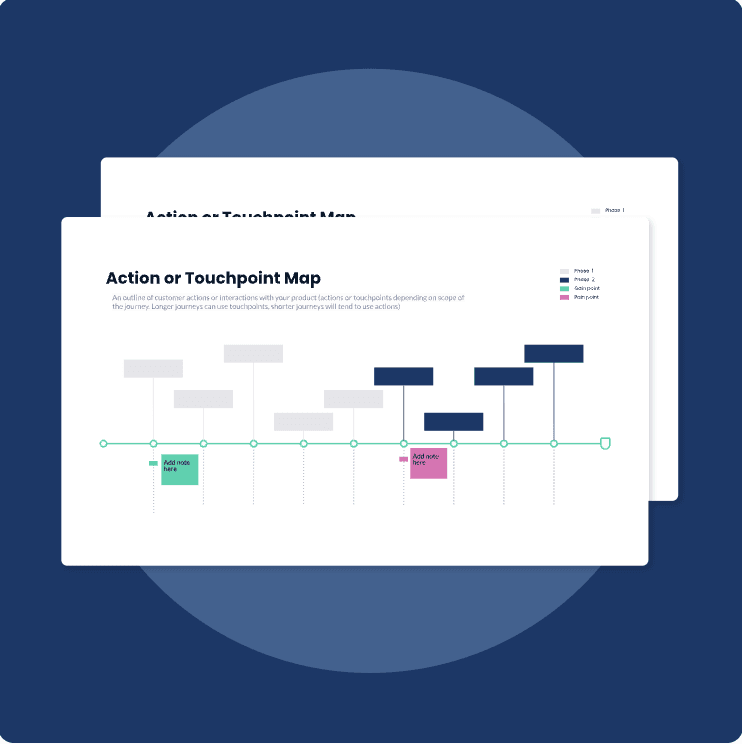Updated: July 31, 2025- 17 min read
Creating engaging user experiences is key to reducing churn. We need to ensure that users feel satisfied with their interactions on the platform.
— Mario Queiroz, Chief Product Officer at Hinge Health, on The Product Podcast
Creating or launching a product takes a lot of thought, effort, and patience. Ideally, the reward for all that hard work is a strong base of engaged users. But sometimes, reality hits, and product adoption falls short of expectations.
After all the hours spent perfecting the product, it’s tough when users don’t fully embrace it. That’s why we’ve put together a guide on building a successful product adoption strategy.
In this article, you’ll find proven steps and strategies to not only attract new users but to convert them into long-term, power users.
Free Customer Journey Map
Put yourself in your customers’ shoes to find the problems in your user experience (and uncover opportunities to solve them).
Download here
What Is a Product Adoption Strategy?
A product adoption strategy is a plan designed to help users discover, understand, and consistently use a product. It’s about guiding users through each stage of their user flow — from first hearing about the product to making it an essential part of their routine.
At its core, a product adoption strategy focuses on making the product easy to understand, valuable, and hard to imagine life without.
It involves everything from creating clear onboarding processes and engaging tutorials to offering the right support at the right time. The goal is simple: turn curious users into loyal advocates, ensuring that your product not only attracts users but keeps them coming back.
The Technology Adoption Curve: Understanding User Behavior

The product adoption curve, originally attributed to Everett M. Rogers, categorizes users into five groups based on their readiness to adopt new innovations: Innovators, Early Adopters, Early Majority, Late Majority, and Laggards. Innovators and Early Adopters are quick to embrace new products, while the Early and Late Majority need more proof of value before committing. Recognizing these segments allows you to tailor your strategy, ensuring the right message and engagement tactics for each group.
How to Increase Product Adoption in 8 Steps
1. Understand Your Users Deeply
Anything related to a product starts with a deep understanding of your users.
Generally, surface-level demographics and user persona are OK. However, deep insights require digging into user behaviors, motivations, and pain points. Any product expert, therefore, will tell you to segment your users based on personas, behaviors, and needs — this helps you tailor your strategy to meet their expectations at each stage of the product adoption.
Start by conducting detailed user research. Use interviews to capture users’ thoughts and emotions, surveys to gather quantitative data, and product analytics to track how users interact with the product. Pay close attention to their onboarding, feature engagement, and drop-off points. Look for patterns that indicate where users get stuck, frustrated, or confused.
Furthermore, when conducting user interviews, don’t just focus on what users say — focus on what they do. Observing user behavior is often more insightful than relying solely on feedback, as users might not always articulate their real challenges.
For example, if users regularly abandon a feature after clicking on it, it could signal that it’s too complex or not delivering immediate value. Analyzing these patterns allows you to identify hidden motivations and barriers.
For smaller teams with limited budgets, regular user testing might be too costly. The great news is that there are other ways to gather meaningful insights.
Explore user reviews, participate in forum discussions, and check out product discussions on platforms like Reddit, Quora, or industry-specific communities. These channels provide a wealth of qualitative feedback that can be quantified too. These platforms can help you better understand users’ thoughts and feelings and guide your strategy without breaking the bank.
2. Act on Clearly Defined Adoption Metrics
When defining your product adoption metrics, think about them as dynamic tools, not static numbers. They should align with user segments, product stages, and overall business goals. Here’s how to make metrics more than just measurements:
Align Metrics with User Segments:
Instead of using a one-size-fits-all approach, adapt your metrics based on different user segments. For example, new users might be best measured by time-to-value and activation, while long-term users should be evaluated based on user retention and feature adoption. This segmentation helps you understand what works for different user groups and where specific adjustments are needed.
Use Metrics to Guide Your Strategy, Not Just Validate It:
If you notice a sudden drop in activation rates, that’s an opportunity to ask why. Dig into user behavior to see where they’re dropping off, and use that insight to refine your onboarding or product messaging. This approach turns product metrics into active tools for strategy development rather than just measurements of success or failure.
Integrate Qualitative Insights with Quantitative Metrics:
You can use tools like exit surveys, user interviews, and even user behavior recordings to gather the context behind the numbers. Also, user reviews, forum discussions, and product discussions on online forums are invaluable sources of qualitative feedback. These insights will help you understand not only how users interact with the product, but also what’s missing or frustrating.
Iterate Regularly Based on Metrics:
Adoption metrics are not set in stone. As your product evolves, so should the metrics you’re tracking. Regularly review your metrics and be ready to adjust based on new user behaviors, market changes, or product updates. This iterative approach keeps your adoption strategy aligned with the product’s growth and user needs.
3. Build a Seamless Onboarding Experience
If users don’t see the value quickly, there’s a good chance they’ll bounce. That’s why the onboarding process needs to be intuitive, engaging, and — above all — focused on quick wins. The faster users can experience the product’s core benefit, the more likely they are to stick around. That’s the formula of a good product adoption model.
Start by keeping things simple. Use interactive walkthroughs, tooltips, and in-app tutorials that guide users step-by-step through the most valuable features.
Avoid overwhelming them with too many options right away. Instead, focus on one or two key actions that showcase the product’s impact. For example, if you’re marketing an AI business tool, make sure users can see the core AI task within seconds.
Pro Insight:
If you have resources, prioritize personalization. Adapt your user onboarding flow to different user segments.
For example, new users might need a basic walkthrough, while advanced users could benefit from a “skip to pro features” option. This approach keeps users engaged based on their level of expertise.
Also, well-timed in-app messages or email prompts can keep users moving forward without being pushy. For instance, if a user stalls after setting up an account, a friendly nudge saying, “You’re almost there—try adding your first task!” can work wonders.
For smaller teams, creating a seamless onboarding flow doesn’t have to be resource-heavy.
You can use tools like Loom to create quick, personalized video tutorials or leverage onboarding platforms like Appcues or Userpilot for automated walkthroughs. Even simple email sequences that guide users step-by-step through the setup can make a huge difference. The key is to make onboarding feel like a personal tour, not a generic slideshow.
4. Enhance Product Visibility Within User Networks
Boosting the product adoption process isn’t solely about individual user engagement — it’s about encouraging users to share their experiences and spread awareness organically. People trust the recommendations of their peers. Therefore building mechanisms for visibility within user and product communities is a powerful tool.
Start by adding shareable features, like in-app achievements. These allow users to showcase milestones or usage statistics on social media. Simple badges, sharable reports, or user-generated content (such as personalized dashboards) can go a long way in spreading awareness.
Consider building referral incentives that reward users who introduce your product to others. Ensure these incentives align with your product’s value. They need to offer benefits like premium features, credits, or exclusive content. This creates a win-win: users feel motivated to share, and you gain new adopters through trusted sources.
For B2B products, consider encouraging “case study” sharing, where users can highlight their successful use of the product on their platforms. Promote user stories through webinars or industry-specific events to reach even broader audiences. The key is to make visibility easy, rewarding, and genuine.
5. Get Leadership Buy-In for a Product Adoption-Aligned Roadmap
One big thing that theory often misses is the internal company dynamic. The real challenge isn’t just ‘having a strategy’ — it’s getting everyone to actually work together. The key?
A product adoption strategy needs to be woven into the product roadmap and product strategy. This means alignment with broader business objectives, ensuring that the entire organization is on board, from product teams to Chief Product Officer.
To boost adoption, you need to integrate adoption-focused milestones into the roadmap. This could mean prioritizing features that drive engagement, refining onboarding flows, or improving key functionalities that users consistently struggle with. In other words, the product roadmap should reflect what we share in this entire piece.
Here’s where leadership buy-in becomes crucial. Without support from senior leadership, it’s tough to align resources, allocate budget, or make adoption-driven changes a priority.
When leadership understands and commits to product adoption as a core part of the strategy, it sets a tone across the organization that adoption is a mission. It ensures that teams don’t treat adoption efforts as fancy lingo to be thrown around but as an integral part of product management.
When you have product leadership backing, it’s easier to rally teams across functions — from engineering and product design to marketing and customer success. It also helps create a culture where user feedback is not only welcomed but acted upon.
Practical Tips for Gaining Leadership Buy-In:
Present Data-Driven Evidence: Use product metrics like activation rates, churn rates, and time-to-value to show where the product is struggling to convert users into regular adopters. This gives leadership a clear, evidence-based view of why adoption needs to be a priority.
Tie Adoption to Business Outcomes: Show how increased adoption directly impacts revenue (check our feature ROI calculator and cost of delay), user retention, and customer lifetime value. When leadership sees a clear connection between adoption and business growth, they’re more likely to invest in adoption-focused initiatives.
Create a Shared Vision: Align adoption efforts with the broader product vision. If the company’s vision is to be the leading solution in the market, frame product adoption as a key pathway to achieving that status. Make it clear that adoption isn’t just about getting more users; it’s about creating engaged, satisfied, and loyal users.
Involve Leadership in User Feedback: Get leaders to participate in user interviews, read user reviews, or join customer calls occasionally. When they hear feedback directly, it can be a powerful motivator to support adoption-focused changes in the product.
6. Personalize Experiences Through Continuous Data-Driven Insights
Personalization plays a pivotal role in keeping users engaged. With customized experiences, you enhance each user flow, adapting to their unique needs, habits, and preferences. To do this effectively, rely on data-driven insights that update continuously. In turn, each experience will feel relevant and tailored.
Use product analytics to track user behavior, from login frequency to feature engagement and even support inquiries. Feed this data back into your product. Allow it to “learn” and adapt. For example, if a user frequently interacts with one feature, highlight related functionalities they haven’t tried yet, or suggest next steps based on their current usage level.
In addition to feature suggestions, consider personalized content that guides users toward greater engagement. Use in-app notifications or targeted emails that recommend tutorials, case studies, or user stories tailored to their industry or use case.
For smaller teams with limited resources, try tools like Intercom or Mixpanel. These can automate personalized messaging based on predefined criteria. This ongoing customization keeps the product fresh and relevant, fostering a sense of connection and satisfaction with the product experience.
7. Implement Behavioral Triggers and Engagement Campaigns
To drive successful product adoption, you need to keep users engaged. Behavioral triggers and personalized engagement campaigns are great tools for nudging users toward meaningful actions, all while keeping the experience natural and user-friendly. Here’s how to do it:
Use In-App Prompts to Drive Action:
In-app prompts guide users toward key features or next steps. These can be as simple as tooltips that highlight a button or a pop-up suggesting the next feature to explore. For example, after users complete a basic action.Send Personalized Emails Based on Behavior:
Personalized emails are your best friends in re-engaging users. These emails should be triggered based on specific actions or inactions. For example, if a user has signed up but hasn’t activated a key feature within a few days, send an email saying, “Hey, you’re one step away from unlocking full potential — here’s how to do it.”Leverage Push Notifications for Timely Nudges:
Push notifications can be used for real-time engagement. These work well for reminding users to complete a task, encouraging them to try a feature, or simply keeping them updated on new product benefits. Make sure they’re relevant and well-timed, or they could become annoying.Create ‘Milestone Moments’ to Encourage Deeper Engagement:
Celebrate when users reach key milestones in the product. For example, when a user completes their first project or achieves a new level of usage, send a celebratory message — whether it’s an in-app badge, an email, or even a simple “Congrats!” message. This keeps users motivated to engage more.Apply Behavioral Triggers Thoughtfully:
Behavioral triggers should be timely and relevant. If users haven’t activated a key feature after a week, send a helpful tip, a success story from other users, or a video tutorial to encourage exploration. The idea is to be helpful, not intrusive.Segment Users for Targeted Campaigns:
Not all users need the same nudges. Segment users based on their actions, engagement level, and usage patterns to create campaigns that speak directly to their needs. For example, new users might need more guidance, while active users might appreciate tips on advanced features.Measure Engagement and Iterate:
Track how users respond to different triggers and campaigns. Use product metrics like click-through rates, feature activation rates, and engagement levels to see what’s working and what’s not. Based on this data, tweak your approach regularly to ensure it stays relevant and effective.
8. Gather Feedback as a Key Step in User Adoption Strategy
No strategy is perfect right out of the gate — especially when it comes to product adoption. Building a strategy is a constant work in progress. It’s all about listening, adapting, and fine-tuning based on real user feedback.
The trick is to make iteration part of your company’s culture. You need a mindset that says, “Good enough is never good enough.” Start by gathering feedback from a variety of sources. Surveys, user interviews, support tickets, in-app feedback forms, and even user behavior analytics can offer rich insights.
Feedback collection isn’t a one-and-done thing. It’s ongoing, and it should be happening across every user segment.
Regularly revisit what users are saying, and look for patterns that indicate both successes and roadblocks. For smaller teams with fewer resources, focus on qualitative insights from user reviews, forum discussions, or even product discussions. These raw, unfiltered conversations often reveal the “real talk” that users might not share directly.
Pro Tips for Iteration:
Run Micro-Experiments: Instead of rolling out massive changes, test small tweaks. For example, try changing the wording of an onboarding email, or adjust the layout of a popular feature. See how users react before making broader changes.
Use Quick Surveys: Send short, targeted surveys right after a user completes an important action. Ask, “How was your experience?” or “What could be better?” These micro-surveys capture insights when the experience is fresh in users’ minds.
Involve Your Team in the Feedback Loop: Don’t keep the feedback to yourself. Share it with engineering, marketing, sales, and support teams. This builds a unified understanding of user needs and ensures that iteration is collaborative.
Close the Loop with Users: When you make a change based on feedback — as some companies do with their product roadmaps — be sure to let users know! If users see that their feedback led to improvements, they’re more likely to stay engaged and continue sharing insights.
6 Bonus Strategies to Boost Adoption in a Product-Led Growth Model
To drive success in a product-led growth model, these strategies focus on empowering users to explore, engage, and adopt your product naturally. Here’s how you can pave the way for sustained growth and deeper user satisfaction.
1. Optimize for Self-Service Onboarding
Product-led growth thrives on allowing users to experience value independently. Try to design an intuitive, self-service onboarding that guides users that doesn’t require human intervention. Use clear instructions, tooltips, and in-app resources like FAQs and tutorials to empower users to get started on their own.
2. Introduce a Freemium or Trial Model
Give users the chance to explore your product risk-free. By offering a freemium or limited-time trial — as these product-led growth examples do — you can drive user interest and adoption by allowing them to test core functionalities. Make sure to highlight key benefits during this period to help users understand the product’s value.
3. Create a Community for Product Users
Establish a community space, like a forum or Slack group. You want users to interact, share insights, and help each other. Community engagement creates a supportive environment that boosts adoption, with users learning from each other’s experiences and discovering new use cases organically.
4. Showcase Quick Wins Through Product Tours
Guide new users toward “quick wins” — small but meaningful actions that immediately demonstrate the product’s value. Short, interactive product tours that lead to these wins can increase user engagement and drive product adoption by making the product’s benefits quickly evident.
5. Prioritize In-Product Upsells for Advanced Features
For users who have achieved some success with your product, strategically introduce upsells within the app to show them the potential of advanced features. This encourages the gradual adoption of more functionalities.
6. Leverage Data to Identify and Nurture Power Users
Track product analytics and user behavior to identify “power users” — individuals who are highly engaged with the product. Create special offers, and advanced tutorials, or invite them to beta test new features. Power users often become advocates, helping to drive adoption by sharing their success stories and referring others.
Don’t Forget The Vital Role of User Insights in Adoption Strategy
As you work through these steps, remember that each tweak, each bit of user feedback, and each iteration brings you closer to a better version of your product.
Take the time to find what works best for your product and team. Ensure it integrates smoothly with your overall product roadmap and goals.
At the end of the day, the right strategy is the one that’s right for you — Use Quick Surveys: Send short, targeted surveys right after a user completes an important
action. Ask, “How was your experience?” or “What could be better?” These micro-surveys
capture insights when the experience is fresh in users’ minds.
Involve Your Team in the Feedback Loop: Don’t keep the feedback to yourself. Share it with
engineering, marketing, sales, and support teams. This builds a unified understanding of user
needs and ensures that iteration is collaborative.Close the Loop with Users: When you make a change based on feedback — as some
companies do with their product roadmaps — be sure to let users know! If users see that
their feedback led to improvements, they’re more likely to stay engaged and continue
sharing insights.
Shape a Product Adoption Plan That Fits You
As you work through these steps, remember that each tweak, each bit of user feedback, and each iteration brings you closer to a better version of your product.
Take the time to find what works best for your product and team. Ensure it integrates smoothly with your overall product roadmap and goals.
At the end of the day, the right strategy is the one that’s right for you — so, your move.
Product Experimentation Certification
Scale growth through data-driven testing. Use AI to optimize acquisition, retention, pricing, and build a culture of high-velocity experiments.
Enroll now
Updated: July 31, 2025





